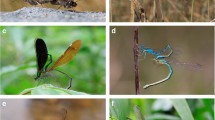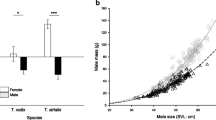Abstract
The rapid divergence of male genitalia is a widely observed evolutionary phenomenon. Although sexual selection is currently regarded as providing the most likely driving force behind genital diversification, the mechanisms responsible are still debated. Here, we investigate the relationship between male genital morphology and sperm transfer in the praying mantid Ciulfina klassi using geometric morphometrics. The shape of male genitalia in C. klassi influenced sperm transfer duration and the number and proportion of sperm transferred, suggesting that genital morphology is under sexual selection in this species. Genital size however was not correlated with any aspect of sperm transfer. Intriguingly, two of the major genital shape components correlated positively with the number of sperm transferred, but negatively with sperm transfer duration. Hence, males that most effectively transfer sperm to the female spermatheca do so in a relatively short period of time. A direct negative relationship was also found between sperm transfer duration and sperm transfer success. Overall, our study suggests that the variable genital shape of Ciulfina may have been selected for more efficient sperm transfer.



Similar content being viewed by others
References
Adams DC, Rohlf FJ, Slice DE (2004) Geometric morphometrics: ten years of progress following the ‘revolution’. Ital J Zool 71:5–16
Arnqvist G (1997) The evolution of animal genitalia: distinguishing between hypotheses by single species studies. Biol J Linn Soc 60:365–379
Arnqvist G (1998) Comparative evidence for the evolution of genitalia by sexual selection. Nature 393:784–786
Arnqvist G, Thornhill R (1998) Evolution of animal genitalia: patterns of phenotypic and genotypic variation and condition dependence of genital and non-genital morphology in water strider (Heteroptera: Gerridae: Insecta). Genet Res Camb 71:193–212
Arnqvist G, Danielsson I (1999) Copulatory behavior, genital morphology and male fertilization success in water striders. Evolution 53:147–156
Arnqvist G, Rowe L (2002) Correlated evolution of male and female morphologies in water striders. Evolution 56:936–947
Arnqvist G, Rowe L (2005) Sexual conflict. Princeton University Press, Princeton
Arnqvist G, Thornhill R, Rowe L (1997) Evolution of animal genitalia: morphological correlates of fitness components in a water strider. J Evol Biol 10:613–640
Arnqvist G, Edvardsson M, Friberg U, Nilsson T (2000) Sexual conflict promotes speciation in insects. PNAS 97:10460–10464
Briceño RD, Eberhard WG (2009) Experimental modifications imply a stimulatory function for male tsetse fly genitalia, supporting cryptic female choice theory. J Evol Biol 22:1516–1525
Carroll SP (1991) The adaptive significance of mate guarding in the soapberry bug, Jadera haematoloma (Hemiptera: Rhopalidae). J Insect Behav 4:509–530
Crudgington HS, Siva-Jothy MT (2000) Genital damage, kicking and early death—the battle of the sexes takes a sinister turn in the bean weevil. Nature 407:855–856
Danielsson I, Askenmo C (1999) Male genital traits and mating interval affect male fertilization success in the water strider Gerris lacustris. Behav Ecol Sociobiol 46:149–156
Dickinson JL (1986) Prolonged mating in the milkweed leaf beetle Labidomera clivicollis clivicollis (Coleoptera: Chrysomelidae): a test of the "sperm-loading" hypothesis. Behav Ecol Sociobiol 18:331–338
Eberhard WG (1985) Sexual selection and animal genitalia. Harvard University Press, Cambridge
Eberhard WG (1993) Evaluating models of sexual selection—genitalia as a test-case. Am Nat 142:564–571
Eberhard WG (1996) Female control: sexual selection by cryptic female choice. Princeton University Press, Princeton
Eberhard WG (2004a) Male–female conflict and genitalia: failure to confirm predictions in insects and spiders. Biol Rev 79:121–186
Eberhard WG (2004b) Rapid divergent evolution of sexual morphology: comparative tests of antagonistic coevolution and traditional female choice. Evolution 58:1947–1970
Eberhard WG (2006) Sexually antagonistic coevolution in insects is associated with only limited morphological diversity. J Evol Biol 19:657–681
Gavrilets S (2000) Rapid evolution of reproductive barriers driven by sexual conflict. Nature 403:886–889
Holwell GI (2007) Spermatophore feeding and mating behaviour in praying mantids (Mantodea: Liturgusidae). J Zool (Lond) 271:255–260
Holwell GI (2008a) Male control of copulation duration in Ciulfina praying mantids (Insecta Mantodea). Ethol Ecol Evol 20:61–70
Holwell GI (2008b) Geographic variation in genital morphology of Ciulfina praying mantids. J Zool (Lond) 276:108–114
Holwell GI, Ginn SG, Herberstein ME (2007) Three new species of Ciulfina Giglio-Tos (Mantodea: Liturgusidae) from north-eastern Australia. Zootaxa 1583:23–35
Hosken DJ, Stockley P (2004) Sexual selection and animal genitalia. TREE 19:87–93
Hotzy C, Arnqvist G (2009) Sperm competition favors harmful males in seed beetles. Curr Biol 19:404–407
House CM, Simmons LW (2003) Genital morphology and fertilization success in the dung beetle Onthophagus taurus: an example of sexually selected male genitalia. Proc R Soc Lond B 270:447–455
Klass KD (1997) The external male genitalia and the phylogeny of Blattaria and Mantodea. Zoologisches Forschungsinstitut und Museum Alexander Koenig, Bonn
Kuntner M, Coddington JA, Schneider JM (2009) Intersexual arms race? Genital coevolution in Nephilid spiders (Araneae, Nephilidae). Evolution 63:1451–1463
Mayr E (1963) Animal species and evolution. Harvard University Press, Cambridge
Otronen M (1998) Male asymmetry and postcopulatory sexual selection in the fly Dryomyza anilis. Behav Ecol Sociobiol 42:185–191
Parker GA (1970) Sperm competition and its evolutionary consequences in the insects. Biol Reviews 45:525–567
Parker GA, Simmons LW (2000) Optimal copula duration in yellow dung flies: ejaculatory duct dimensions and size-dependent sperm displacement. Evolution 54:924–935
Rodriguez V, Windsor D, Eberhard WG (2004) Tortoise beetle genitalia and demonstrations of a sexually selected advantage for flagellum length in Chelymorpha alternans (Chrysomelidae, Cassidini, Stolaini). In: Jolivet P, Santiago-Blay JA, Schmitt M (eds) New developments on the biology of the Chrysomelidae. SPB, The Hague, pp 739–748
Rohlf FJ (1997) tpsRelw—relative warp analysis (Windows) version 1.09. Department of Ecology and Evolution, State University of New York, New York
Rohlf FJ (2004) TpsDig2. Department of Ecology and Evolution, State University of New York at Stony Brook, Stony Brook
Rohlf FJ, Marcus LF (1993) A revolution in morphometrics. TREE 8:129–134
Rönn J, Katvala M, Arnqvist G (2007) Coevolution between harmful male genitalia and female resistance in seed beetles. PNAS 104:10921–10925
Shapiro AM, Porter AH (1989) The lock and key hypothesis: evolutionary and biosystematic interpretation of insect genitalia. Ann Rev Ent 34:231–245
Simmons LW (2001) Sperm competition and its evolutionary consequences in the insects. Princeton University Press, Princeton
Sota T, Kubota K (1998) Genital lock-and-key as a selective agent against hybridization. Evolution 52:1507–1513
Tadler A (1999) Selection of a conspicuous male genitalic trait in the seedbug Lygaeus simulans. Proc Roy Soc Lond B 266:1773–1777
Umbers K (2006) Natural paternity in Ciulfina mantids (Mantodea: Liturgusidae) as evidenced by wild-sired progeny arrays. Honours Thesis. Macquarie University
Usami T, Yokoyama J, Kubota K, Kawata M (2006) Genital lock-and-key system and premating isolation by mate preference in carabid beetles (Carabus subgenus Ohomopterus). Biol J Linn Soc 87:145–154
Waage JK (1979) Dual function of the damselfly penis: sperm removal and transfer. Science 203:916–918
Wenninger EJ, Averill AL (2006) Influence of body and genital morphology on relative male fertilization success in oriental beetle. Behav Ecol 17:656–663
Winnick CG, Holwell GI, Herberstein ME (2009) Internal reproductive anatomy of the praying mantid Ciulfina klassi (Mantodea: Liturgusidae). Arthropod Struct Dev 38:60–69
Zelditch ML, Swiderski DL, Sheets HD, Fink WL (2004) Geometric morphometrics for biologists: a primer. Elsevier, San Diego
Acknowledgements
We wish to thank Kate Umbers and Stuart Allen for assistance with field collection of mantids. We also thank Ray Cameron and Peter Tung for assistance with digital imaging. We particularly thank Luke Finley for morphometric advice and anonymous reviewers for helpful comments on this manuscript. This research adhered to the Association for the Study of Animal Behaviour/Animal Behavior Society Guidelines for the Use of Animals in Research, Australian legal requirements and Macquarie University animal ethic guidelines. Funding was provided by the Australian Research Council (DP0662873) and Macquarie University.
Author information
Authors and Affiliations
Corresponding author
Additional information
Communicated by L. Simmons
Rights and permissions
About this article
Cite this article
Holwell, G.I., Winnick, C., Tregenza, T. et al. Genital shape correlates with sperm transfer success in the praying mantis Ciulfina klassi (Insecta: Mantodea). Behav Ecol Sociobiol 64, 617–625 (2010). https://doi.org/10.1007/s00265-009-0879-2
Received:
Revised:
Accepted:
Published:
Issue Date:
DOI: https://doi.org/10.1007/s00265-009-0879-2




